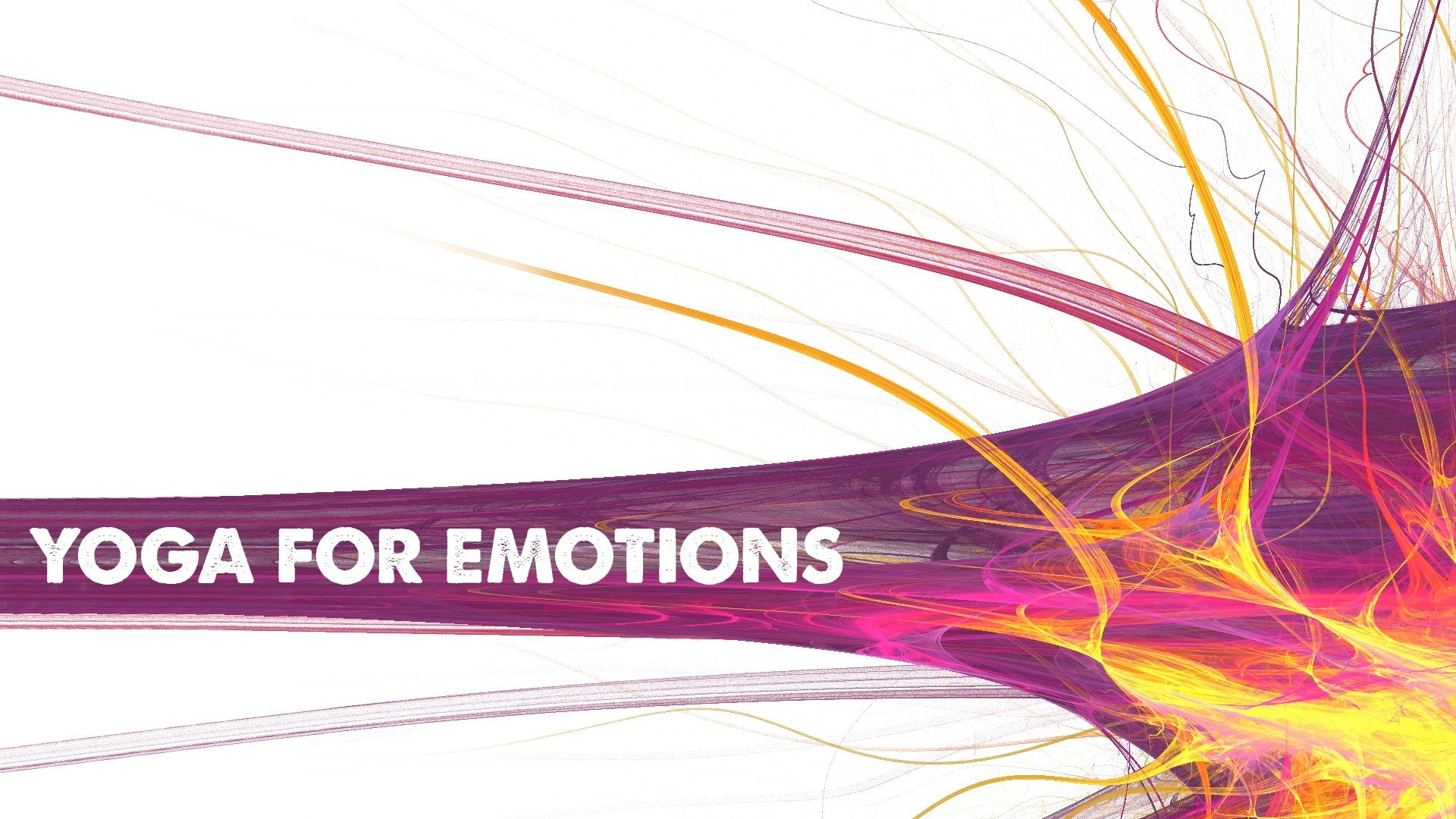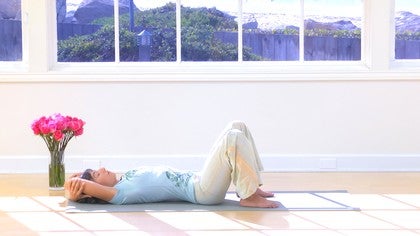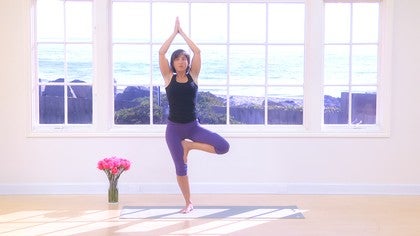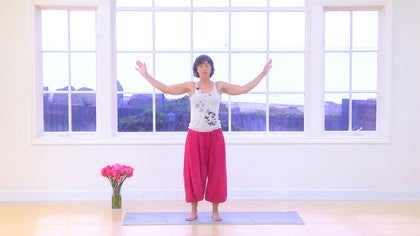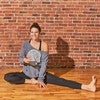Description
About This Video
Transcript
Read Full Transcript
So we're gonna start laying down so we can prepare ourselves to stay in Shavasana. So you're welcome to follow me. This is how I really like to start my practice, so I have... So I give myself a little bit of time to really listen to what it is inside today. And for this I really need to lay down and I will allow some movements in my body. And I invite you to join me with this practice and see how it feels for you.
So when you get to your mat just lay down, find a comfortable posture, find your way in Shavasana, your own way. Just allow the whole body to relax so you're really giving yourself to the ground without restrictions. There's no one else here with you, it's just you, your body, the mat and the ground. And you can start observing the movement of the breathing in the body. So you can feel that every time you breathe in, this inhalation brings movement into your body. And every time you breathe out, the exhalation brings also movement into the body. So you're tuning with your breathing and at the same time you're tuning with your body and the sensations of the breathing in the body. And most important, you're keeping your mind busy, bringing the mind into the breathing and the body. But sometimes we can get a little bit restless here so my suggestion for today is that we start moving a little bit so then we can lay down in Shavasana for a little bit longer. So bend your knees, feet flat on the ground and feel how the sensation of your body with the floor, it's completely different now. So your body weight feels completely different now. The sacrum is really available to you right now. And the idea is that you keep your legs relaxed. There is no tension in the muscles of your legs. So you can really allow your pelvis to roll at the position that it feels more comfortable. So when you are not in control anymore, you're just laying here and allowing your pelvis to roll in a way that it feels organic, natural. Feel the breathing. Now observe also the contact of the upper back with the floor. It's exactly the same. You don't want to control how this contact is. Just allow your body to find its own way so you can feel the shoulder blades and the arms relaxed. And just feel the breathing in here. And finally observe what happens when you open your arms in an angle next to your head. And now, wow, your chest is quite open. It seems like your heart is really open. And just feel the breathing here in this new disposition. So you're just giving a chance to your body for opening. So your legs are soft. Your pelvis is relaxed. There is no grip in your hips.
Your heart feels open and your arms should be relaxed. So if you have some restriction in your arms and if you want to really make a 90 degree angle, sometimes it's a little bit weird and your arms stays like this. That doesn't make any sense because you can't really relax here. And what you really want when you are in Shavasana is to find this complete relaxation surrendering completely. So maybe you need to widen this angle a little bit. So find your own way to do it. That's the most important thing when we're practicing yoga. Okay. So now you just start rolling your pelvis softly. And again here, the idea is that you keep it soft so when you're rolling your pelvis, it's not because you're using your abdominal muscles or your thigh muscles. It's just because you keep your pelvis free. So the more you free your pelvis, the more soft and nice the movement will be. So just keep on moving your pelvis. Rolling on top of your sacrum doesn't have to be a wide movement. It can be a small movement. So you start bringing a little bit of movement into the spine. And you can see that you are moving your pelvis, but actually what is happening is that the whole spine is moving, even your head is moving. So this movement you're starting in your pelvis is traveling all the way up your spine. You can feel your chin moving closer to your chest and your chin moving away from your chest. So this can be almost like a meditative movement, meditative movement. You're kind of in a meditation here, really aware of what you're doing, mindful of the movement you are creating from the hips, from the pelvis, and aware of what this movement you're bringing into your pelvis is bringing into the whole body. So you can feel also the chest opening. You can feel the sensation of the shoulder blades, back of the head. And there is a natural way of breathing here. It happens in a really natural way actually. When you breathe in, so when you breathe in it's like your pubic bone is moving away from your navel and your lower back is arching. And when you breathe out, it's the opposite movement. It seems like your lower back is flattening and the pubic bone moving closer to your navel. But that really happens in a pretty natural way. Okay, so pause and just feel. Stop the movement and allow yourself to feel all the movement inside when you're not doing anything. Now you can bring your arms up. Play a little bit here. And you can start bringing one arm really high up so your shoulder is lifting the ground and then the other one. So when you bring the hand high up you see the shoulder lifting the ground and then relax completely the shoulder back to the floor. And allow your head to move freely so you're not telling your head what to do, you're just telling your arms what to do. And again, you breathe with the movement in the way that it feels more natural. And now let's go with both arms. So bring both arms up and relax. And can you be mindful of the movement you're doing but at the same time be aware of what is resonating in you when you do this? What is happening in your body? How does it feel? How does the breathing feel when you do this? Where can you feel this movement you're doing with your arms and your body? Okay, let's hug. Big hug, soft.
With your hands you're touching your shoulder blades. You can stretch your neck a little bit more. And then you want to walk with this hand a little bit farther away but keep your knees facing up and just go back. And you do this a few times, same side. So basically the arm you have closer to your chin is the arm that walks away from the body. So the shoulder is moving away from the floor. It's a small torsion. It's a baby torsion. Allowing the shoulder blade to move. And again, your head is free. So you're not telling your head what to do. You're just allowing your head to move in a free way. Bring the arms up. And the chin sides. So hug again. Nice hug. Hello. And chin sides. Breathing the arms up. Relax the shoulders. Bend your arms and hold with each hand the opposite elbow and bring the arms over your head. And here again, it's about softening, freeing the body. You don't want to push. Like this, I'm pushing. I'm making an effort to bring my arms down. That doesn't make any sense because we are just preparing the body for the session. So let's be soft. So just allow your arms to hang. It's okay if they don't touch the floor. In my case, they don't do. It feels really good. And then I can observe how gravity is pulling them down softly. And the more I let go, the more I lose the grip in my shoulders. The more I stop wanting to control, the more movement I can observe. And that's the magic of yoga. It's just observing what happens when you stop making an effort, when you stop directing things, controlling things, wanting things to be in a certain way. What is it there today? And your hips are soft, your legs are soft, your jaws are soft. And you can spread your knees away, bringing the sole of the feet together. That feels really nice. And you can even spread your arms. Find any grip between your hands that you like, whatever feels better for you. And stay here breathing softly. Okay, and let's go back to this position of arms in angle. And this time we're going to spread the feet. So the outside of the feet is in line with the edge of the mat. And then just bring your knees to one side so you feel that there is a little bit of opening in the side of the body and the hip moving away from the armpit. And if that feels right, maybe you can even bring the opposite foot on top of the thigh or the knee. Brings a little bit more leverage. And then maybe you can even bring these arms a little bit higher up so you can really feel like the side of the body is opening. This is really yummy. I like this a lot. And stay here for as long as it feels right. And if you put your foot there on top of your thigh and you realize that's too much, just change it. Go back. Just follow your intuition what is right for you. And then you change side, bring the knees up and move them to the other side. For me it feels right to bring this foot on top of the thigh. Then I stretch and allow your head to be in a position that feels good for you also. So you're not telling your head what to do. The head knows where to go, where to stay. And be observing this opening of the side of the body. So you keep your mind in the body all the time. That's the idea of this tuning with the body. To be ready to listen to what the body has to tell. Okay. And now I'm ready to go back to shavasana. Let's do final movement. So just bring the feet in an inward rotation and then outward. So you're rolling your legs from your hips. And then do the same with the arms. Inward and outward. So just playing, you know, take a little bit of playfulness into the body. You want to do this, at least when you start, then sometimes you'll get really serious. But when you start, why don't you play with the body a little bit? And then maybe the head left and right, soft. And now you're ready to just stay here in shavasana and listen. So I'm going to sit up now, but I would suggest that you stay here laying down while I guide you with some suggestions that can help listening. So now that we have brought a little bit of movement into shavasana, we can lay down in a more relaxed way so you can really be in the body and listening. And I really like to start the session like asking these big questions like, how am I feeling today? How is the body feeling? So how is the body feeling? Can you see if your body is tense or tight in some parts of the body? Or it feels open and relaxed in other parts? And also, what is the general atmosphere, the general tone in your body today? And this is related with maybe there is an emotion that it's there today, that it's really obvious like I feel sad or just I don't have energy at all or the opposite. I feel excited. I have so much energy or I'm super happy or I'm in love, whatever it's there today right now in this moment. So listening to the present moment while it's there. And maybe it's not something or maybe it's something that you can't label, you can't put a name on it. It's okay, just feel it because the idea is not to give name to things, it's just to feel them. And then how is the mind? Is the mind agitated or is the mind calm? Is the mind talking a lot or the mind or it's easy to keep the mind in the body all the time? Because the suggestion is that you bring the mind into your body so that you switch from the thinking mode, which is the mode that we usually operate in all the time, to the feeling mode. So when we go to the Yagamat, we want to go to this feeling mode, being with the sensations in the body, instead of following the thoughts of our mind. So just stay here, noticing what it is today right now, what is true in you right now. This listening is really useful because then it can guide your practice. So if you are following a certain practice that someone is leading, you can work in a certain way respecting how is your being today. Or if you're practicing on your own at home, you can decide what to do, that it can help you feel better or more respectful with what it is real today in you. So that's my suggestion for working with Shavasana. Namaste, thank you for being here.
Yoga for Emotions
Comments
You need to be a subscriber to post a comment.
Please Log In or Create an Account to start your free trial.
